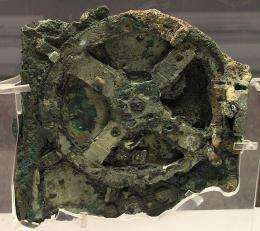April 4, 2011 report
Ancient Greek calculating device continues to reveal secrets

(PhysOrg.com) -- It's known as the Antikythera mechanism, a metal gear driven device found over a century ago on a sunken Roman ship, near the island of Antikythera, that for just as many years has had scientists analyzing, scratching their heads and offering suggestions as to its purpose.
Some have called the device the first analog computer; others the first mechanical computing device. Either way, the device very clearly demonstrates that the Greeks of 150 to 100 BCE knew far more about gears and calculating machines than had been thought possible just a decade or so ago.
After careful analysis with an x-ray tomography machine which allowed the device to be seen as a series of slices that could then be used to see all the way through the mechanism slice by slice (as is done with the same machine when analyzing organs inside a living human being) researchers, particularly Michael Wright, now of Imperial College, London, have come to believe they have almost a full understanding of what the machines was built to do; and that, was to calculate the position of celestial bodies.
Wright has even built (completed in 2006) what he believes to be an almost exact replica of the device.
If modern research is correct, the device worked by hand cranking a main dial to display a chosen date, causing the wheels and gears inside to display (via tabs on separate dials) the position of the sun, moon, and the five known planets at that time, for that date; a mechanical and technical feat that would not be seen again until the fourteenth century in Europe with precision clocks.
Also, some of the early research showed that the device actually used special gears to account for the elliptical shape of the moon’s orbit to account for what appeared to be a speed up and slow down as the moon moved around the Earth.
Now James Evans and his colleagues at the University of Puget Sound in Washington State, have shown that instead of trying to use the same kind of gear mechanism to account for the elliptical path the Earth takes around the sun, and subsequent apparent changes in speed, the inventor of the device may have taken a different tack, and that was to stretch or distort the zodiac on the dial face to change the width of the spaces on the face to make up for the slightly different amount of time that is represented as the hand moves around the face.
In a paper published in the Journal for the History of Astronomy, Evans describes how he and his team were able to examine x-rays taken of the corroded machine (69 then later 88 degrees of the circle) and discovered that the two circles that were used to represent the Zodiac and Egyptian calendar respectively, did indeed differ just enough to account for what appeared to be the irregular movement during different parts of the year.
Though not all experts agree on the findings, this new evidence does appear to suggest that an attempt was made by the early inventor to take into account the elliptical nature of the Earth orbiting the sun, no small thing.
Some have attributed the technical anomaly of the existence of the Antikythera mechanism, to visitation by aliens, others have suggested it wasn’t the Greeks at all that came up with the technology, but the ancient Babylonians, who passed on the gains they had made in not just mechanical engineering, but math and astronomy as well. Either way, it’s clear that early civilizations came to know and understand much more about the world around them then modern society has given them credit for and as our own understanding of the sciences grows, we come to see that it’s quite possible that a lot of the things we take for granted as inventions of the modern era, are simply recreations of work done by our forebears.
More information:
via Wired
© 2010 PhysOrg.com

















